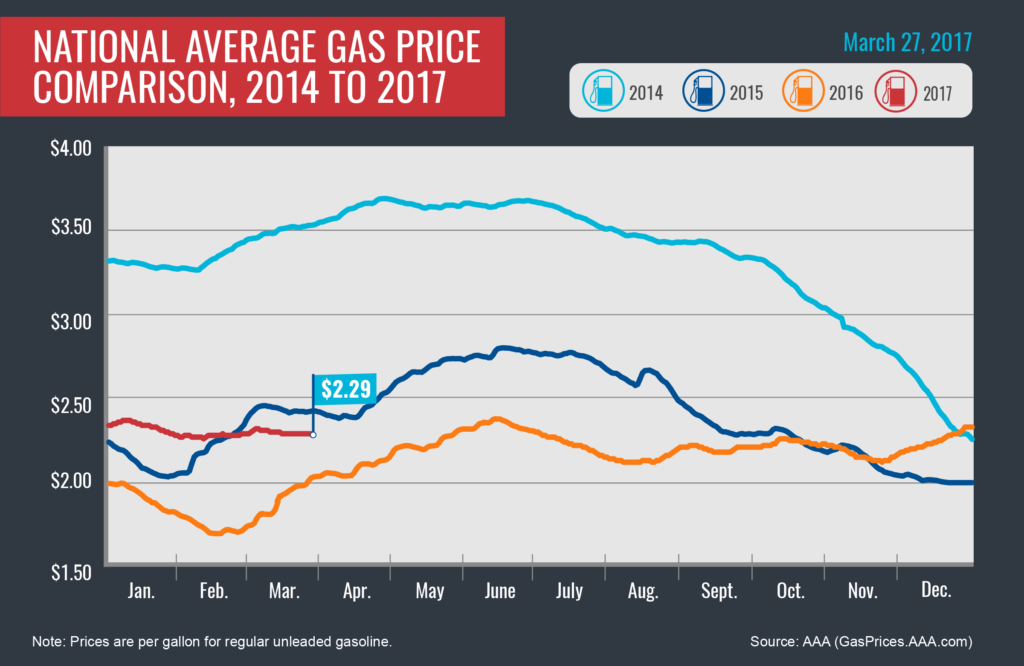Today’s national average price at the pump is $2.29 per gallon. This is the same price as compared to one month ago, but just fractions of a penny below one week ago and 25 cents per gallon more than the same date last year. The average pump price has decreased nine of the past 10 days.

On Sunday, a joint committee of ministers representing OPEC and non-OPEC countries asked the OPEC Secretariat to examine the market and consider a possible production cut extension beyond the original six- month agreement. Last year, OPEC and non-OPEC countries agreed to cut their output by 1.8 million barrels a day for six months starting in January 2017. The Secretariat is expected to provide a recommendation in April, well before the current agreement is set to expire in June.
Quick Stats
- The nation’s markets that have seen the largest yearly increases in gas prices are: Washington (+56 cents), Utah (+51 cents), Oregon (+50 cents), Hawaii (+49 cents), Alaska (+49 cents), Idaho (+48 cents), New Jersey (+46 cents), Montana (+38 cents), New Mexico (+34 cents) and Pennsylvania (+34 cents).
- The nation’s markets that have the least expensive weekly gas prices include: South Carolina ($2.02), Tennessee ($2.04), Alabama ($2.05), Mississippi ($2.05), Oklahoma ($2.06), Missouri ($2.07) Arkansas ($2.07), Virginia ($2.10), Louisiana ($2.10) and Texas ($2.11).

West Coast
Prices on the West Coast remain flat, with six states topping the list of most expensive markets: Hawaii ($3.07), California ($2.98), Washington ($2.84), Alaska ($2.79), Oregon ($2.67) and Nevada ($2.65). The West Coast is also home to some of the largest year over year price increases: Washington (+56 cents), Oregon (+50 cents), Hawaii (+49 cents) and Alaska (+49 cents). The latest Energy Information Administration (EIA) report shows that despite a nearly five percent increase in refinery utilization, gasoline inventories in the region dropped 428,000 bbl to 28.599 million bbl last week.
Rockies
Drivers in the Rockies have not seen much movement at the pump this week, with prices moving +/- 2 cents or less in most markets. The region historically has been among the more stable in the nation due to its insulated location. However, supply issues resulting from problems on the Wahsatch Pipeline earlier this year has landed Utah (+51 cents), Idaho (+48 cents) and Montana (+38 cents), on the top 10 list of largest yearly increases.
Great Lakes and Central States
Drivers in the Great Lakes and Central regions saw the largest discounts at the pump last week, with seven states topping the list of largest weekly declines: Ohio (-7 cents), Michigan (-7 cents), Indiana (-6 cents), Missouri (-4 cents), Illinois (-3 cents), Iowa (-3 cents) and Kentucky (-2 cents). OPIS reports that the region has been clearing its system of high-RVP gasoline in preparation for the switch to lower RVP summer blend gasoline next month. The switch will mean higher prices at the pump for drivers in both regions.
Mid-Atlantic and Northeast
Prices in much of the Mid-Atlantic and Northeast remain relatively steady on the week with Pennsylvania ($2.48) and Washington D.C. ($2.45) both landing on the list of top 10 most expensive markets. Regional gasoline inventories remain low as the region continues to remove winter-grade gasoline from the system. Pump prices in the region will likely begin to climb around April 10, when gasoline RVP in the New York market makes the official shift to summer-grade blends.

South and Southeast
Drivers in the South and Southeast regions continue to enjoy the lowest prices at the pump with six states landing on the nation’s list of cheapest retail markets: South Carolina ($2.02), Alabama ($2.05), Mississippi ($2.05), Arkansas ($2.07), Louisiana ($2.10) and Texas ($2.11). The latest EIA report shows that regional gasoline inventories remained steady last week while refinery utilization rates increased three percent. OPIS reports that the increases will help stabilize gasoline supply as refineries wrap-up spring maintenance and prepare for the busy summer refining season.
Oil Market Dynamics
Today the market opened posting losses, as traders doubt the ability of OPEC and other major oil producers to rebalance the market. OPEC’s recent announcement to consider extending production cuts follows news from EIA showing a crude oil build of 5 million barrels for the week ending March 17. That increase brings U.S. inventory levels to a total of 533.1 million barrels. Additionally, Baker Hughes’ reports that the U.S. added 21 oil rigs last week, bringing the country’s total rig count to 652.
The combination of OPEC efforts to rebalance the market and increased U.S. production continues to put pressure on crude oil futures, holding prices below $50 a barrel. Next month, market watchers will pay close attention to the OPEC Secretariat’s upcoming recommendations on whether to extend production cuts beyond June. At the close of Friday’s formal trading session on the NYMEX, WTI was up 27 cents to settle at $47.97 per barrel.
Motorists can find current gas prices along their route with the free AAA Mobile app for iPhone, iPad and Android. The app can also be used to map a route, find discounts, book a hotel and access AAA roadside assistance. Learn more at AAA.com/mobile.
